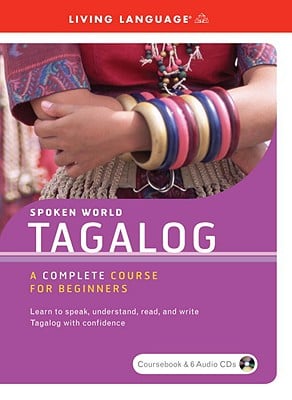Living Language (LL) is a relatively well-known publisher of foreign language course books. Their instructional courses are quite affordable, and when you take a look at the reviews on Amazon, you will notice four to five stars in most LL books. If you are looking for instructional books that use ‘traditional’ method – focusing on ‘assimilation’ and using lots of dialogues, then this is definitely a good series to check out. However, not all LL books are created equal. As a Filipino, I’ll give you my two cents on Spoken World Series–Tagalog: a course book for beginners from Living Language.
"What I really like about this book is how the author managed to be systematic when it comes to introducing the language"
Now, before I begin to critique this book, allow me to briefly talk about the language –Tagalog. A friend of mine from the US asked me how difficult is it to learn Tagalog. Knowing that the Philippines was colonized by Spain for centuries, she thought that Tagalog is somewhat similar to Spanish. Perhaps you too may be wondering if the two languages are related. Now, to make things clear, only 15% of Tagalog vocabulary is based in Spanish, and grammatically, they are hardly similar. The good thing is that Tagalog sounds similar to Spanish – both have that staccato sound (i.e. short and distinct sound with somewhat rhythmic beat). If you are curious to know how difficult it is, I can say that it is probably harder than Italian or Spanish, but not as complex as compared to languages in the Far East like Japanese, Korean and Chinese.
To learn Tagalog, it would help to work on Spoken World:Tagalog Book for Beginners. This book is ideal for those who plan to travel to the Philippines, perhaps for a vacation or a business trip, assuming there’s no previous knowledge of the language at all. This is really perfect for beginners since the author introduces the language in a very basic and simple way. The book consists of 15 lessons and every lesson is divided into 8 sections (A-H). At the first part of the book is the map of the Philippines, followed by the course outline (i.e. table of contents). The Introduction discusses how to use the book providing a brief explanation of each section in the lessons, as well as emphasizing the necessity to use the audio CD when studying the book. These sections include vocabulary warm-up, dialogue, vocabulary, key phrases, culture notes, grammar, reading and independent challenge. After the Introduction is the Tagalog Pronunciation section, covering the Tagalog vowels, consonants and stress, and then the Lessons.

Each lesson begins with a vocabulary warm-up, followed by a dialogue- or listening activity. After each dialogue, there is a short comprehension practice to test what you understand from the dialogue. Vocabulary and key phrases come next. One thing worth pointing out is the inclusion of cultural notes, which talk about Philippine values, customs and history. This is actually an interesting part because the readers will not only learn the language but they will become familiar with the general culture as well.
As for the grammar, the Tagalog language heavily uses affix when changing root words into verbs or nouns. This aspect of Tagalog has been addressed (although not too detailed) by the book and each lesson also has a reading section, which is presented in both Tagalog and English. At the end of the book readers will also find an extensive Tagalog-English glossary.
What I really like about this book is how the author managed to be systematic when it comes to introducing the language, beginning from the formal and informal greetings in Lesson 1 and 2, followed by the concept of family and home (Lesson 3 and 4), daily routines (Lesson 5), school (Lesson 6) and leisure and workplace setting (Lesson 14). The grammar instruction is also thorough without being too rigid. The exercises and independent challenge are also not too lengthy and difficult, with answer keys at the end of the exercise. Overall, this is a solid material for beginners, not too difficult and complex – seemingly adequate I suppose. Both teachers and students will benefit from using this dynamic course book.




